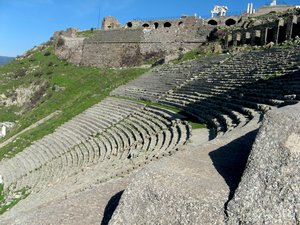Advertisement
Published: March 3rd 2010

 The theatre
The theatre
With the acropolis in the backgroundYesterday we made our way up the coast of the Aegean to Bergama (Pergamum). We are travelling to Canakkale and this was a good way to break up that journey, while offering us the opportunity to visit the spectacular Acropolis.
Pergamum was one of the ancient world's major powers during the 3rd and 2nd centuries BC. Lysimachus, one of Alexander the Great's generals and friend, stored his lootings up here. The old city is perched high on a hill and has a spectacular view of the surrounding plains - it would be easy to see it's appeal for defensive purposes, and in fact Pergamum was able to hold off the Gauls here making them quite celebrated during Hellenic times. For some reason, the ruler Attalus III (Lysimachus' son) bequeathed Pergamum to Rome on his death in 133 BC, making the entire kingdom into Rome's province of Asia and "transforming Rome's economy with its wealth".
Pergamum's library was famous and held over 200,000 books. Jealous Egyptians banned the sale of papyrus to Pergamum who instead developed a new paper using animal skins, known as parchment. The entire library was transported to Alexandria by Cleopatra - who stopped off in Ephesus
after ransacking the place (remember my photo in Ephesus where I pointed out the gate that Cleopatra (and her new husband Anthony) passed through?). Ultimately it was all destroyed in the 7th century AD by a Caliph who considered the books un-Islamic.
Today there is a winding 4 mile road up the 'hill' to the Acropolis, giving stunning views and every so often glimpses of old stone walls. Some excavation work has taken place, but much was ransacked and scattered in museums throughout the world. The Altar of Zeus, for instance was sent to Berlin's Pergamom Museum, including a 400 foot long frieze depicting the battle of gods and giants.
The theatre is built on the west side of the 'hill' and has spectacular views. It is in remarkably good condition, and we spent some time climbing around on it. By the way, many of the theatres that I have captured in this blog are in use today during specific music and art festivals, and have seen performances by the likes of Sting, Dylan as well as classical musicians. It would be magical to see a concert at one of these ancient sites. This theatre can apparently seat
10,000, and I can confirm that the acoustics are grand. The bottom of the theatre area holds the remains of the Temple of Athena. I cannot describe the setting and how awe-inspiring it is.
We then paid a quick visit to Asklepion, which is reputedly the first medical clinic established. The entrance is the columned Holy Road, once connecting Asklepion to the Acropolis, and the site contained a Temple to Artemis, a full library, a theatre where counselling took place, and of healing baths were prescribed in nearby mud and sacred water baths. The symbol tells the story of a sick man who was turned away, only to take poison from a snake that in fact revived him instead of killing him. This symbol is used today by the medical profession.
(An aside: while up at the Acropolis we became aware of many fighter jets taking flight overhead. These are quite loud so are very noticeable, and we were curious as to whether there is a base nearby or whether something was up. Later we noticed a significant police and military presence - the Asklepion is right beside a military shooting range (gotta wonder about that choice...), and
we thought it unusual at the large number of folks on guard, but then again had no idea of what is the normal approach here. The next day while on the bus to Canukkale we saw trains loaded with tanks and other weaponry all heading south. We decided there must simply be maneuvers going on, until a few days later when we caught the news in english and wondered if there was a connection....).
We spent the afternoon exploring the old city of Bergama and its crowded and colourful busy streets. The next day we caught a bus to Canakkale - it was a weird experience because we caught it on the side of a highway in the middle of nowhere outside of town. Bergama is not a huge metropolis, but we did have a few moments of concern thinking we should have been at an otogar (bus station) at least.....but all was well. The bus arrived, had an onboard attendant who served drinks, and individual tv sets. Take that, Greyhound! Four hours later we arrived in Canakkale and found our hotel very near where we had disembarked. We are liking Canakkale and its vibe - and the staff
at our hotel are great. We have made arrangements to visit Gallipoli tomorrow and Troy the day after.
-------------------------
The place we stayed in Pergamum was really not memorable. It was fine for one night but I am sure there are other places that are much better. Location is not really an issue, if you are in town you can walk anywhere. We did notice the Gobi Pension that looked clean and refurbished.
Advertisement
Tot: 0.295s; Tpl: 0.015s; cc: 12; qc: 58; dbt: 0.0705s; 1; m:domysql w:travelblog (10.17.0.13); sld: 1;
; mem: 1.2mb
























